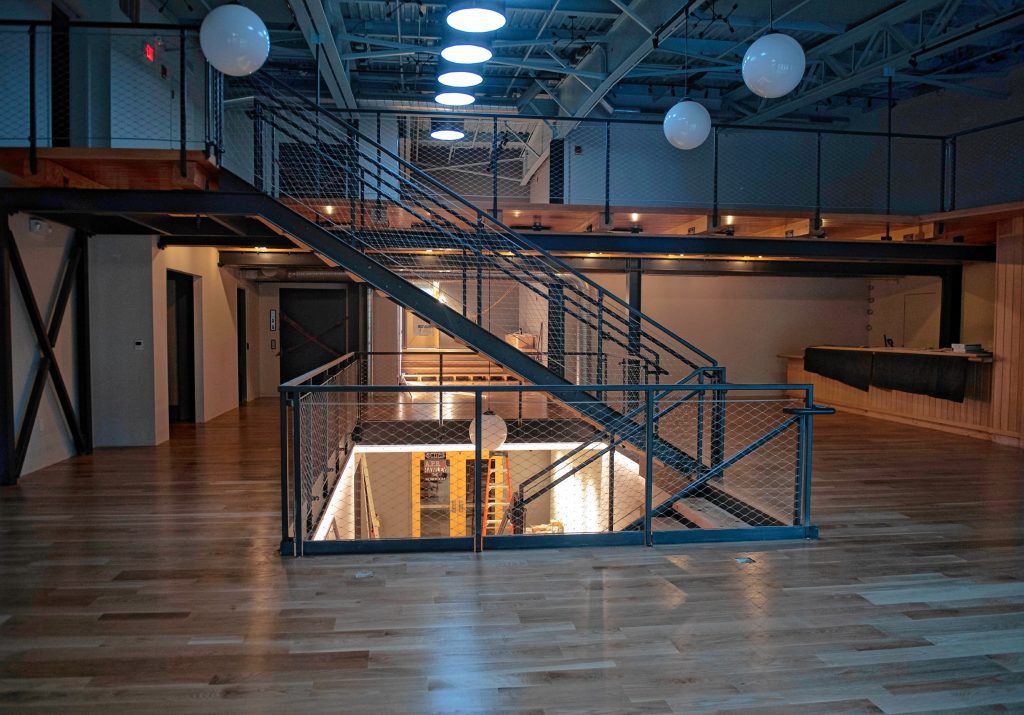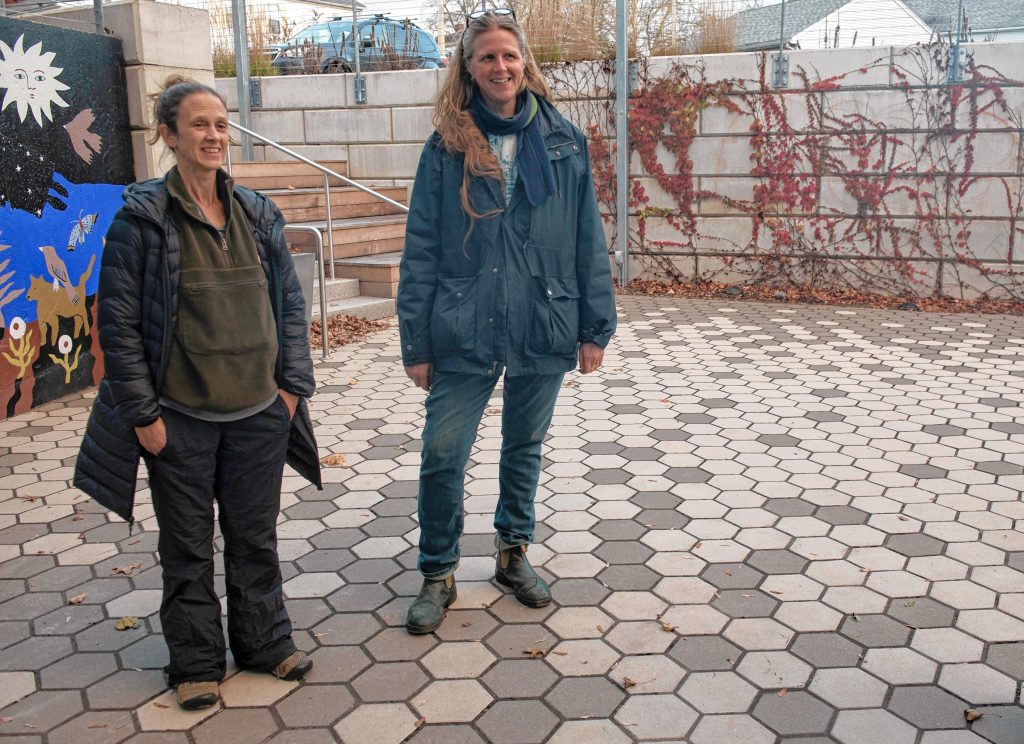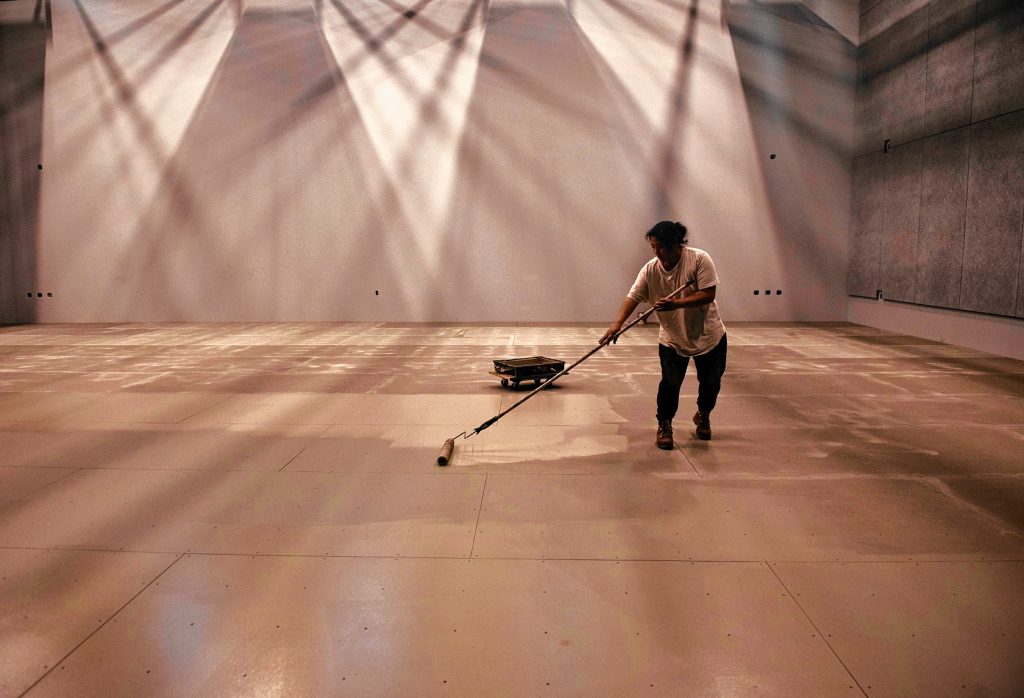By STEVE PFARRER
Staff Writer
It’s been a long run — but the finish line is now in view.
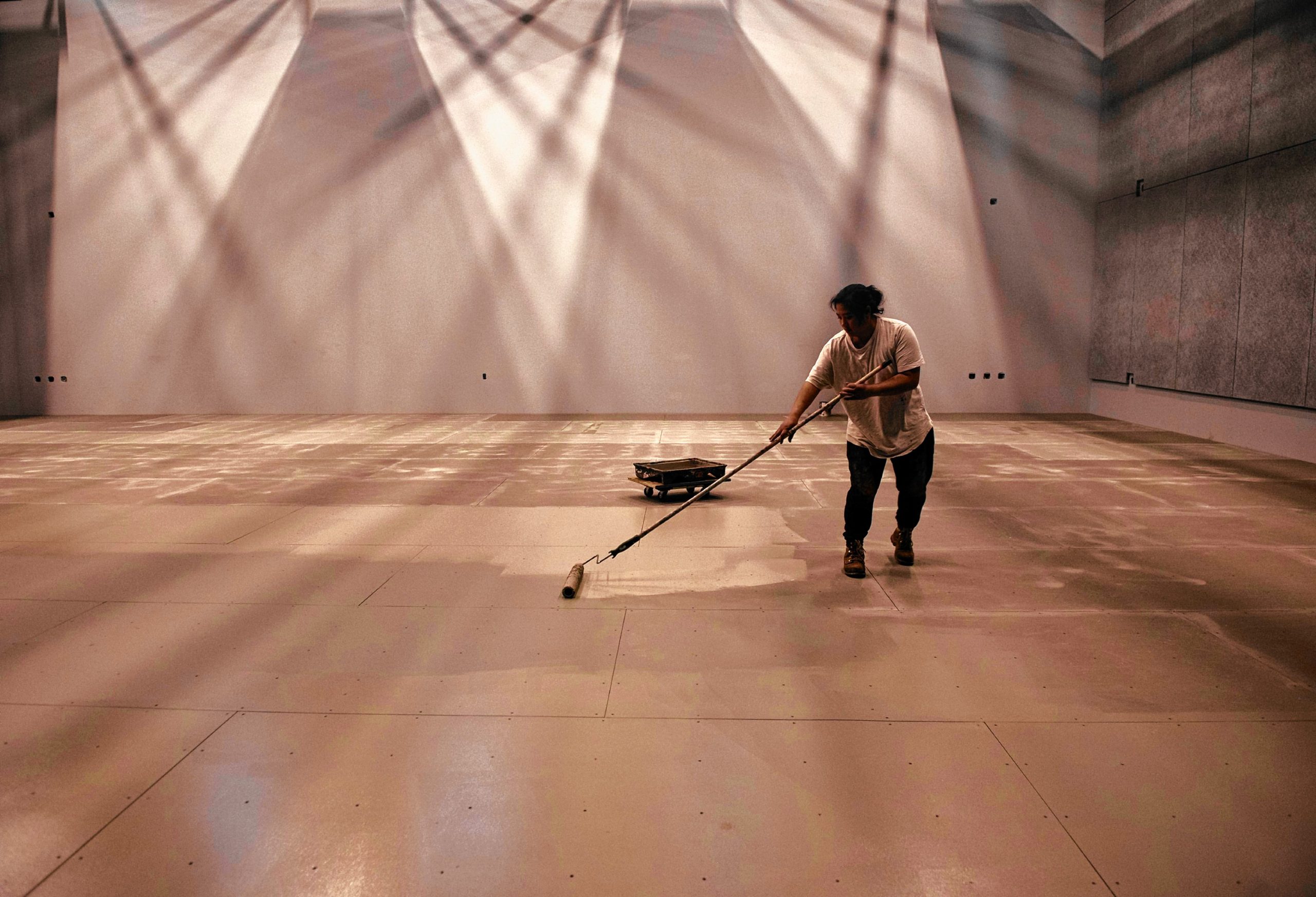
STAFF PHOTO/CAROL LOLLIS
Merisa Dion, an employee at Wooden Kiwi, paints the floor of the Workroom, the largest performance space at 33 Hawley.
The Northampton Community Arts Trust building, largely or partly shuttered for most of this year, is poised to reopen, as work to make the final improvements in the 25,000-square-foot building is almost complete.
From new floors, added soundproofing in the two main performance areas, a concession stand and box office, and an expansive green room and changing areas for performers, the work to finish what’s known as 33 Hawley Street caps an effort that began over 10 years ago to create a community space for supporting the arts in the city.
The building has been entirely closed since late summer, with the three partner organizations that use space there — Available Potential Enterprises Ltd. (A.P.E.), Northampton Center for the Arts (NCFA), and Northampton Open Media (NOM) — working remotely or using other locations.
Another group, Northampton’s School for Contemporary Dance & Thought (SCDT), has also used the building regularly in the last few years but has been working elsewhere in more recent months.
Earlier this year, the building was open on late weekday afternoons and evenings and on weekends for some performances and activities, though the largest space, known as the Workroom, was closed.
But Mollye Maxner, co-director of A.P.E., said the three partner groups planned to be back in their respective office spaces in the building the first week of December, and some events are planned for later in the month — with a fuller schedule set for January, including an invitation for the public to view the space on Jan. 12 as part of Arts Night Out.
“We’re just thrilled to reach this point,” Maxner said during a recent tour of the building. “It’s something we’ve looked forward to for so long, that so many people have looked forward to.”
Dorothy Nemetz, a longtime Arts Trust board member and currently its treasurer, said 33 Hawley has benefited from many sources of government funding, at all levels, as well as targeted fundraising campaigns and generous individual donors, to finance the roughly $10 million project, construction of which began back in 2015.
Also key has been support from politicians in Massachusetts “who really went to bat for us and understood what we were trying to do,” added Nemetz.
She pointed to Stan Rosenberg and Peter Kocot, the former Massachusetts Senate president from Amherst and the late state representative from Northampton, respectively, as important early allies. Then there’s U.S. Rep. Jim McGovern, whose office secured $2.5 million in federal funding in spring 2022 to help the Arts Trust finish construction.
And the late Gordon Thorne, the co-founder of A.P.E. and the former co-owner of Thornes Market, was a huge proponent of the project and provided the vision of what it could be, Nemetz said.
“Gordon was an angel — he was the one who convinced us we could use the (CSA) farm share model for an arts center, that it could be supported by the community,” she said.
Kathy Couch, a co-director of A.P.E. with Maxner, echoes that thought, noting that 33 Hawley has specifically been created to provide opportunities for a wide range of artists to showcase their work, and actually earn income from it.
“We treat work as a creative endeavor,” said Couch. “We don’t have a set idea of what can or should be here. We want to be open to all kinds of different expression … That could be very different 10 years from now.”
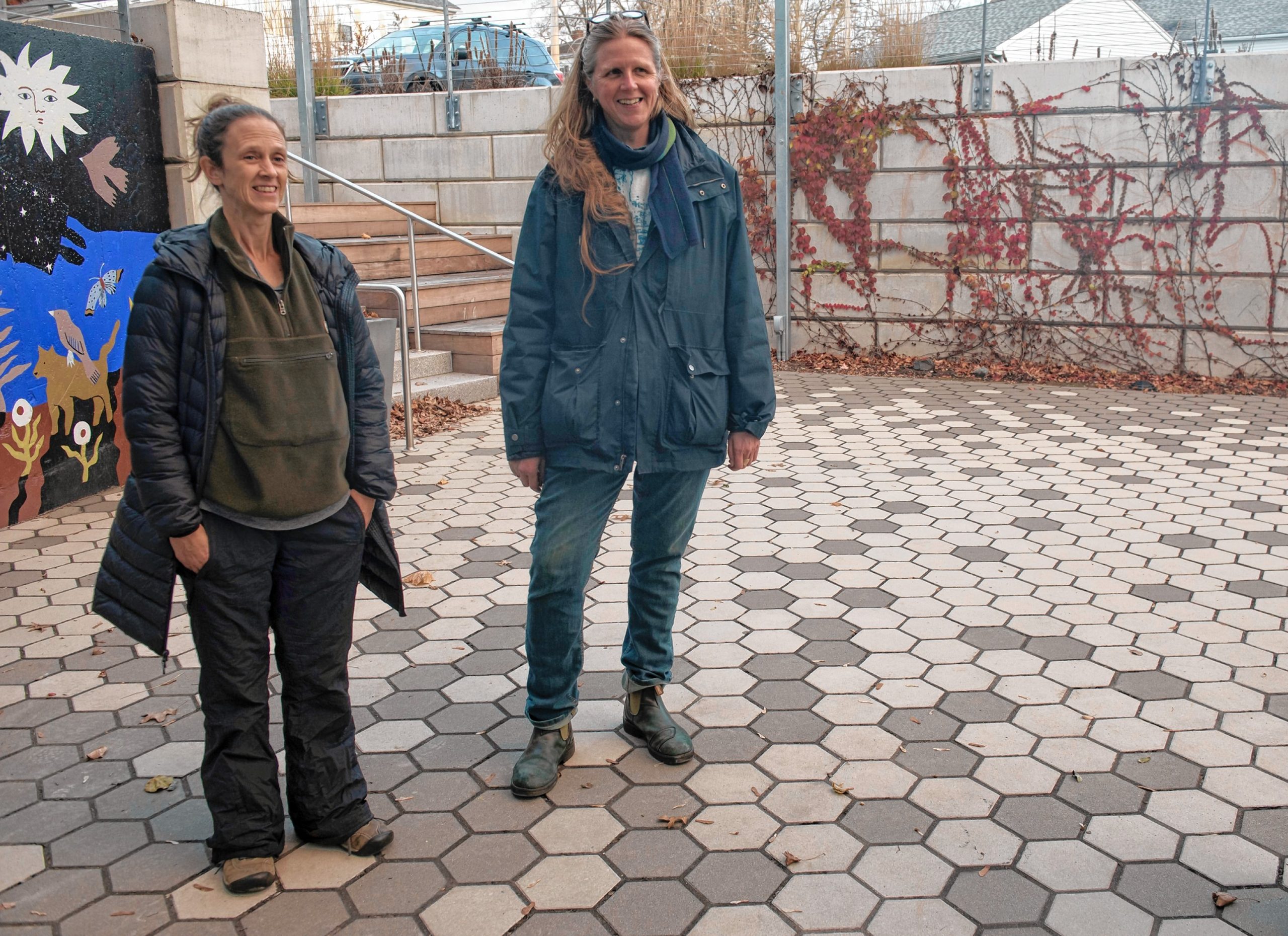
STAFF PHOTO/CAROL LOLLIS
Mollye Maxner and Kathy Couch, co-directors of A.P.E. Ltd., in the courtyard of 33 Hawley. The two are coordinating with many area theater groups and other artists to plan events at the community arts building in 2024.
A moveable fete
The centerpiece of 33 Hawley might be the 3,800 square foot Workroom, designed as a multi-use venue suitable for theater, dance, music and more; it’s administered by A.P.E.
It’s now been transformed from a somewhat drafty, rattling space to one with finished walls, thick soundproofing, overhead catwalks that allow for varied lighting, and a flexible “sprung floor,” with built-in give to absorb impact and lessen the chance for injuries to dancers.
The Workroom will have varied seating, Maxner says, that can be moved to accommodate different kinds and sizes of performances; maximum seating could probably be about 200, Couch says.
The space has already attracted much interest from area theater companies and other organizations, Maxner noted. Nine theater groups so far have become part of a new “Workroom Cooperative” with A.P.E., in which organizations pay an annual fee and then are allocated regular space for performances, rehearsals and more during the year, starting in 2024.
“It’s like a timeshare,” said Maxner. “The idea is to keep it affordable so as many people as possible can participate. It’s not to make a profit.”
The Workwoom also will be available for artist residencies, workshops and other events.
One entry to the Workroom now leads to the green room, which is not yet complete but will have a number of amenities, such as a small kitchen, once finished. The green room connects through another passage to 33 Hawley’s other main performance area, the Flex Space, which is administered by NCFA.
Maxner and Couch said sound could bleed between the two performance areas, making scheduling a challenge. The building’s new soundproofing will allow for shows in both rooms to take place at the same time.
The building’s lobby, inside the main entrance, also sports a bright new look, with the old plywood subfloor replaced by a polished hardwood floor, while a box office and a concession stand have been added to the space.
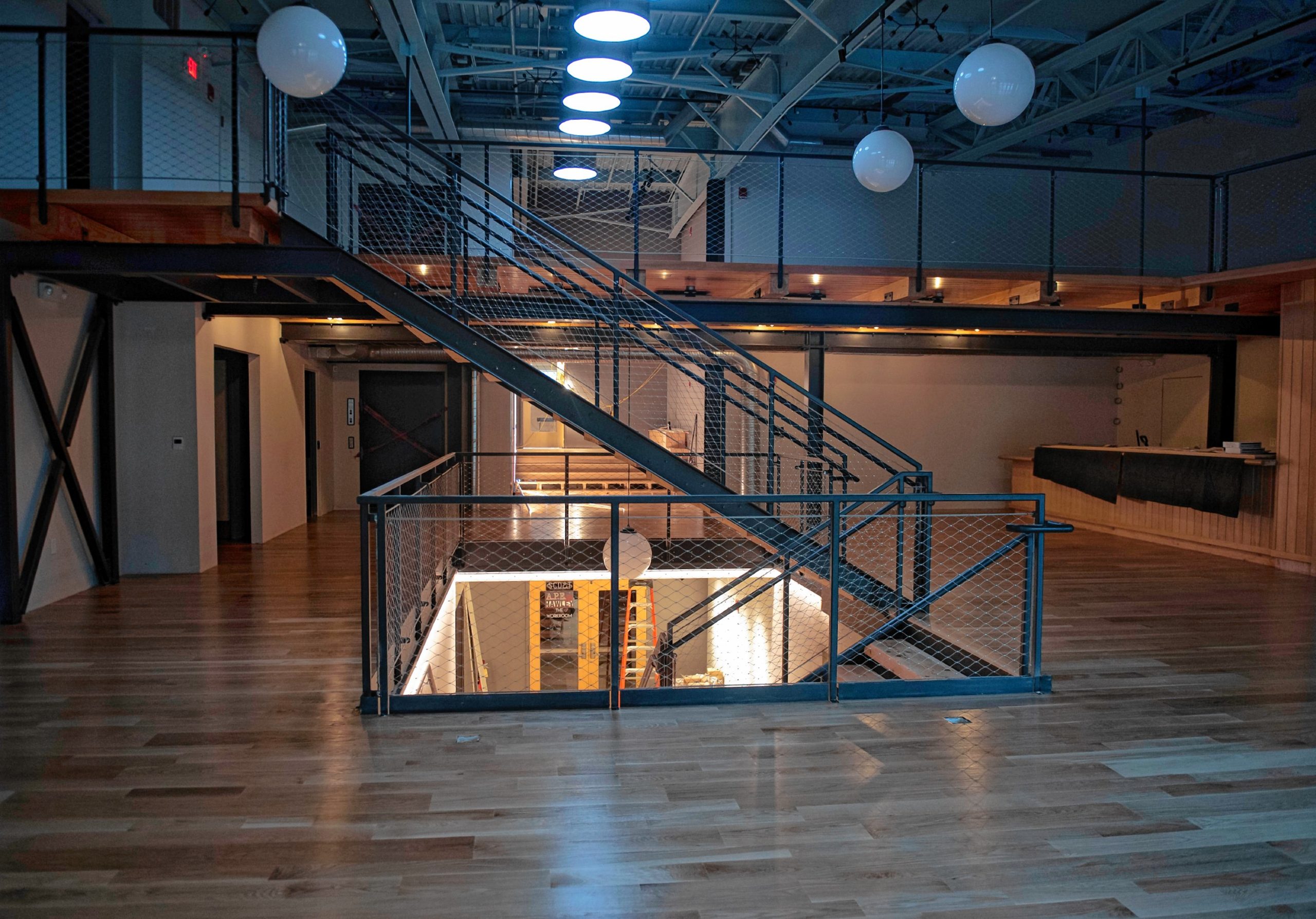
STAFF PHOTO/CAROL LOLLIS
The lobby at 33 Hawley, just off the main entranceway, now sports a polished hardwood floor, a box office, and a concession stand. Just to the left, off camera, is a dedicated art gallery.
Just off the lobby, a dedicated art gallery, where exhibits will take place regularly, also has been completed; artwork will be displayed as well in the lobby and the mezzanine area just above it, Nemetz says.
A good part of the extensive work on the building can’t actually be seen: It’s behind the walls, above the ceilings, and beneath the floors, from plumbing and HVAC systems to extensive wiring for lighting and sound.
Couch notes, for instance, that the wiring has been designed to allow NOM, which has worked closely with A.P.E. and NCFA on previous projects, to do live streaming of events in the building, a practice that started during the pandemic.
Future events at 33 Hawley are still being planned, but some are now on the schedule, including First Night Northampton performances Dec. 31, and a multi-disciplinary show in mid January.
Nemetz looks back on the long road to getting 33 Hawley off the ground with a sense of wonder. The Arts Trust bought the property, previously a combined gym and day care center, in 2013 but had been looking for space for some years before that, with all options falling through, she noted.
Then, almost by happenstance, the trust heard the Hawley Street property was for sale — and bought it.
“And now here we are,” Nemetz said. “It seems hard to believe in some ways, but we finally made it.”
Steve Pfarrer can be reached at spfarrer@gazettenet.com.

